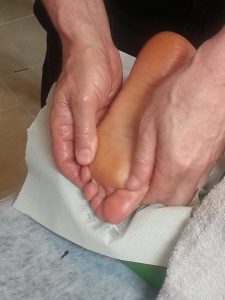Edema, also known as hydroposy, is a medical condition in which an excessive amount of fluid accumulates beneath the skin. If you fall and hit your knee, for instance, fluid may fill the joint to the point where it causes severe pain, discomfort and limited mobility. During the natural and normal healing process, the body will reabsorb this fluid and full mobility will be restored. In some cases, however, swelling and fluid retention may persist, and massage therapy can be a very beneficial strategy to help decrease this excess fluid.
Areas Prone to Water Retention
 Certain areas of the body – typically the lower legs and feet – are more prone to edema than others. Many people who work on their feet for eight or more hours a day may experience edema, due to the sheer stress placed on their feet. This is particularly common among retail and restaurant workers, many of whom stand for long stretches of time without taking a break.
Certain areas of the body – typically the lower legs and feet – are more prone to edema than others. Many people who work on their feet for eight or more hours a day may experience edema, due to the sheer stress placed on their feet. This is particularly common among retail and restaurant workers, many of whom stand for long stretches of time without taking a break.
How Massage Works to Treat Edema
The good news is that massage therapy can treat or even eliminate edema, depending on its location and severity. Manual lymphatic drainage is a common technique used by massage therapists to help drain excess fluid from the person’s body. It involves the use of very light touch strokes, performed generally toward the heart, that encourage greater movement of the lymphatic fluid. When the lymphatic system is stimulated, it forces fluid and waste out of the body; thus, reducing the severity of edema.
Massage works to treat edema by pushing the excess fluid from the body. Swelling, particularly when triggered by blunt-force trauma, causes fluid to “pool” and collect in cavities within the body. Massage therapy guides the fluid away from these collecting sites, allowing it to be flushed through the lymphatic system.
Tips on Receiving Massage for Edema:
- Find a massage therapist who is experienced in lymphatic drainage.
- Explain to your massage therapist beforehand that you are suffering from edema, and show him or her where the swelling is located.
- Cut back on your intake of sodium in the days leading up to the massage, as excess sodium may promote further fluid retention.
- Avoid stressing the area where the fluid has collected.
- Minor forms of edema may be treated through self-massage, assuming you can reach the area.
Give me a call today for more information on how you can better your health!
